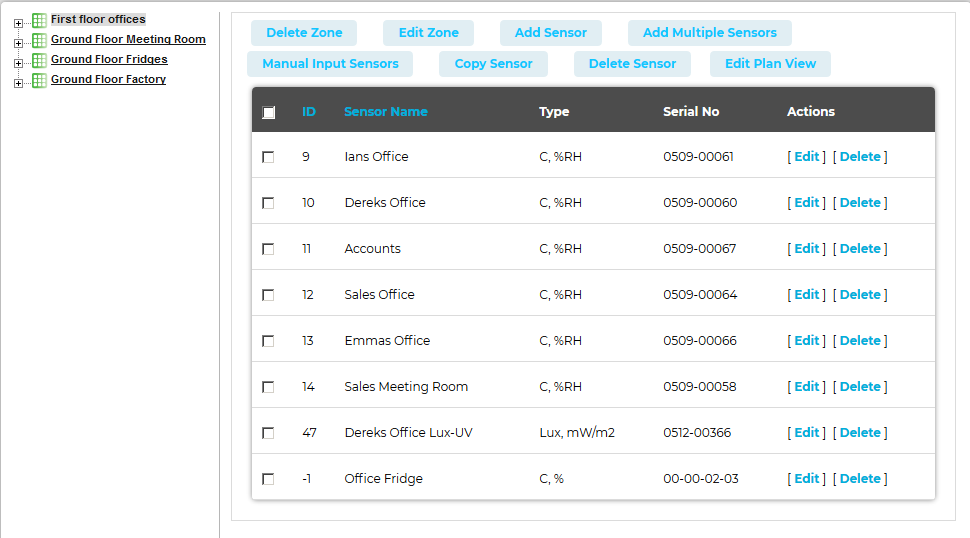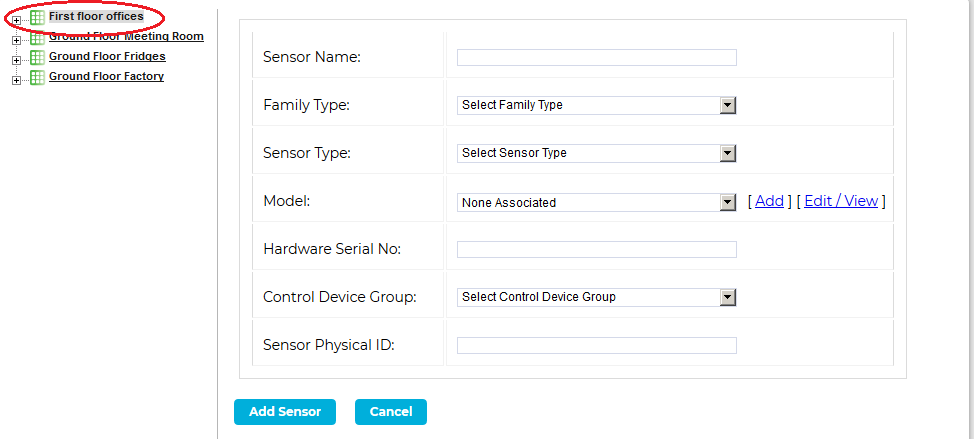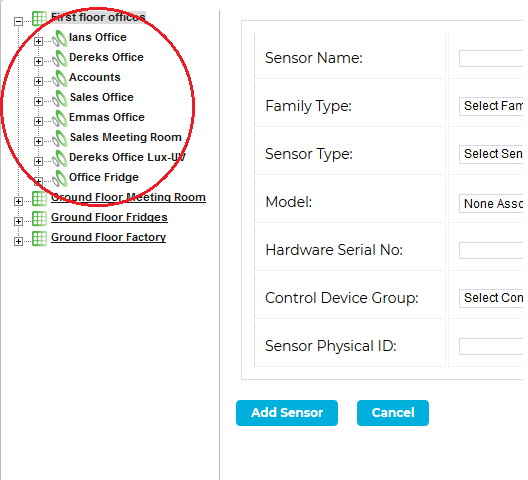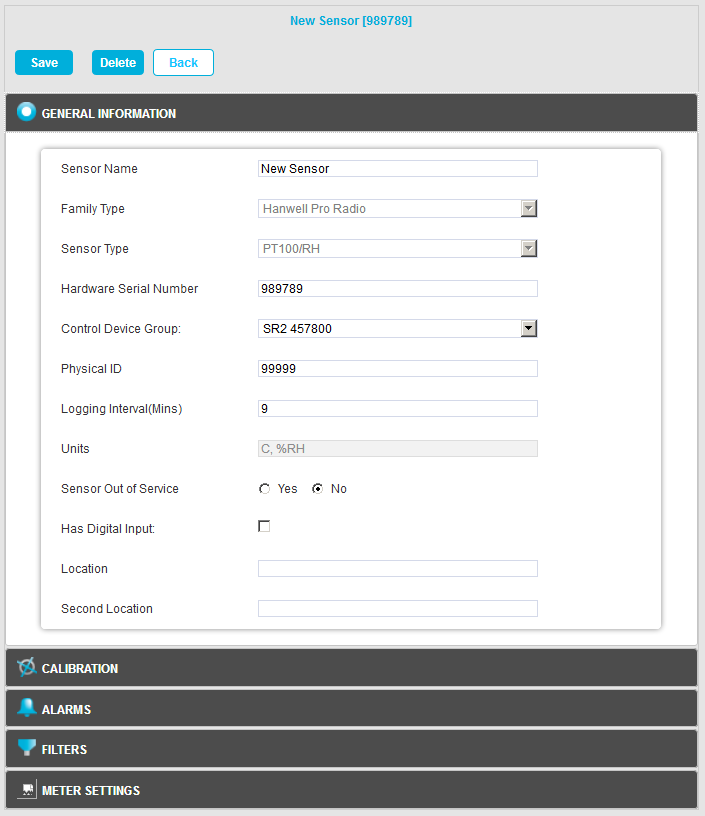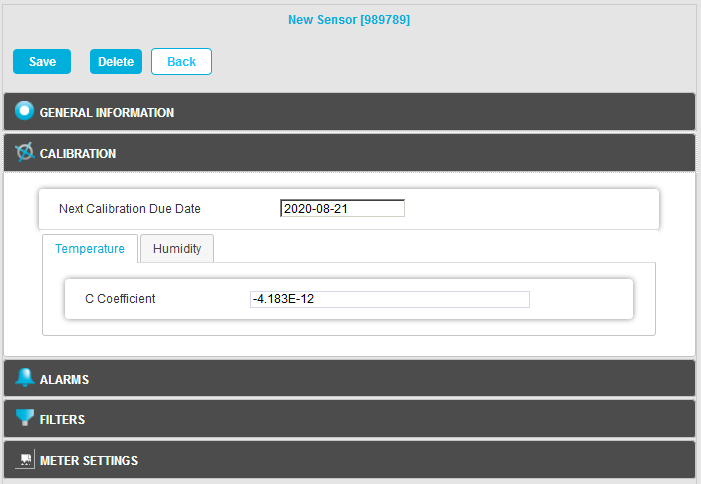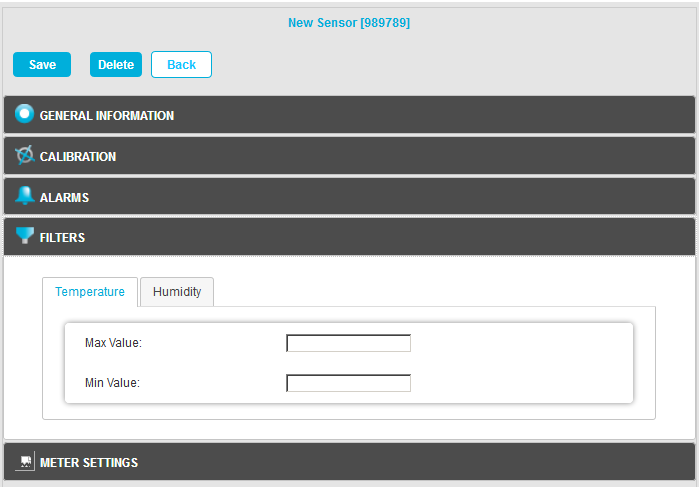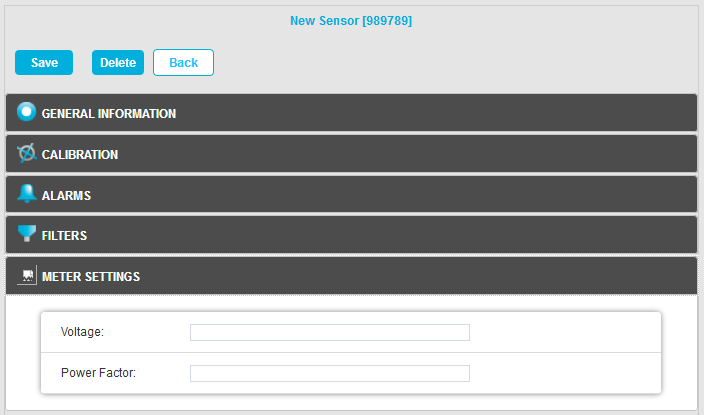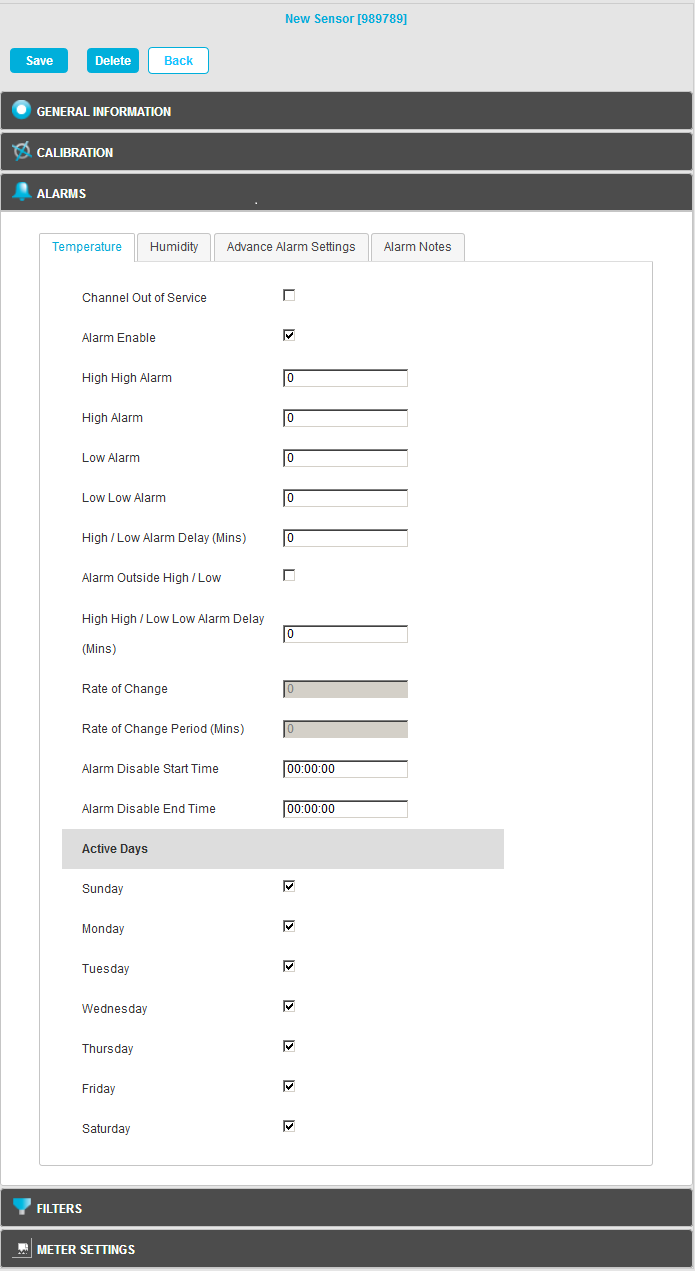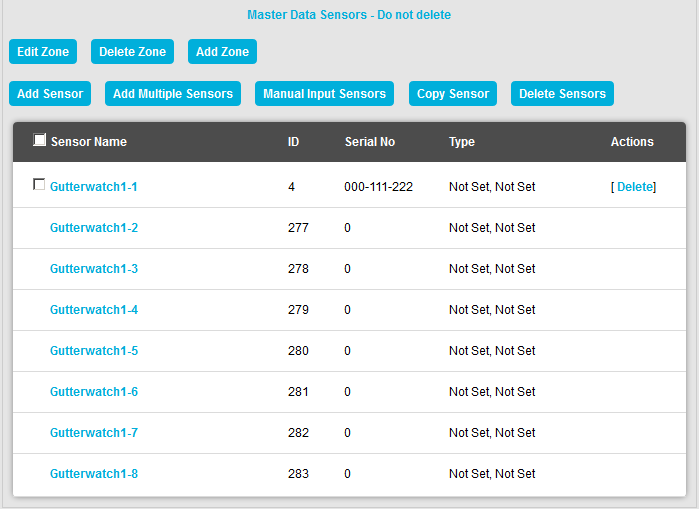Navigation:
System Configuration Sensors > Sensors >> Add/Assign Sensors to a Zone
Add/Assign Sensors to a Zone
Having defined Zones, Sensors can now be added/assigned to them.
•To Add Individual Sensors to a Zone
•To Add Multiple Sensors to a Zone
| Note: | If Sub-Sites are required, they MUST be added to a Site BEFORE Sensors are added. > When a Site is sub-divided into Sub-Sites, Sensors can only be added to the Site's Sub-Sites. |
Adding Individual Sensors to a Zone
1.Click on the Sites radio button.
2.Either:
Click on the View Data icon on the relevant Site's Dashboard icon. See Figure 686 below:
Figure 686
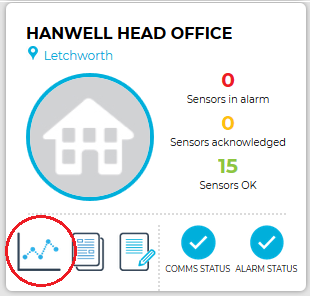
Or:
i.Select Table View from the OVERVIEW drop down menu. See Figure 687 below:
Figure 687
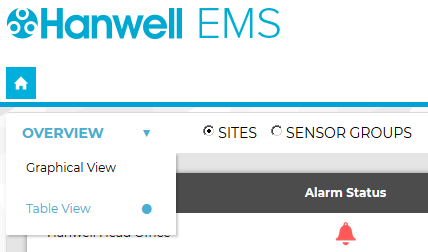
•The Sites Table View window is displayed. See Figure 688 below:
Figure 688

ii.On the Sites Table View window, click on the View Data icon associated with the Site you wish to view the Zones for. See Figure 689 below:
Figure 689

•In both cases, a Live View window is displayed for the selected Site, showing the Sensors associated with the first Zone listed. See Figure 690 below:
Figure 690

➢ To select another Zone, click here.
•Letting the mouse pointer hover over a Sensor Name in the Live View Table displays information in a popup window relating to the selected Sensor regarding Location, Alarms, Date and Time, Battery, Sensor Status etc. See Figure 691 below:
Figure 691

3.Select Edit Mode from the main View Data menu. See Figure 692 below:
Figure 692
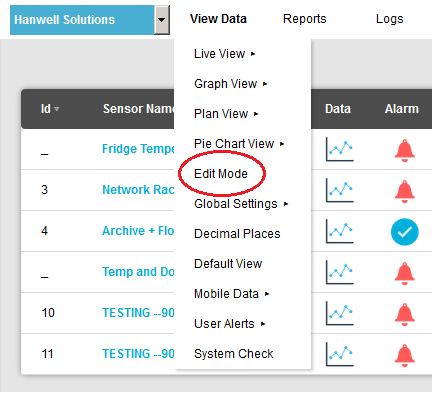
•The Editing and Configuration window is displayed. See Figure 693 below: Figure 693
•By default, the Editing and Configuration window for the Zone at the top of the left-hand menu is displayed. •To display another Zone's Editing and Configuration window, click on the entry for the required Zone in the left-hand menu. For an example. See Figure 694 below: Figure 694
4.Click on the Add Sensor button (see Figure 694 above) to display the Add Sensor window for the selected Zone. See Figure 695 below: Figure 695
•You will notice, in the example above, that the Zone 'First floor offices' is highlighted. This is the Zone that the new Sensor will be added to. •Clicking the Sensor Physical ID: heading once or twice displays the Sensor List in ascending or descending ID number order. •Clicking the Sensor Name: heading once or twice displays the Sensor List in ascending or descending alphabetical Sensor Name order. 5.Fill in the details of the sensor to be added to the selected Zone. The required details are: •Sensor Name: Here you can type a name for the Sensor that means something in relation to either the type of measurement that the Sensor is making or the location, for example, RH/T Room 1 or Room 1. For this example we are going to call our Sensor, 'RH/T Room 1'. •Family Type: The ‘family’ for the sensor you are adding. Select from: ➢Hanwell Pro Radio ➢iSense ➢Hanwell IceSpy Radio ➢Manual Input ➢Hanwell Pro Logger ➢Hanwell IceSpy Legacy Scout ➢ML/RL2000 •Sensor Type: Select the type of Sensor you are adding from the drop down menu. Descriptions of all of the available Sensor types can be found on our website. For this example we will add a temperature and humidity sensor, the standard temperature and humidity sensor can be found in the list as Thermistor/RH.
•Model: This field is not mandatory, you can use the add button to add a list of sensor types or families. This is an aide-mémoire and serves no operational function within the software. This is the Transmitter Serial Number and can be found on the back of the transmitter. •Control Device Group: ➢The Control Device Group is the wireless receiving device that will receive the data from the transmitters. ➢The Control Device Group is selected from the drop down menu. ❖Select the Control Device Group which corresponds to the Site and is compatible with the wireless transmitters used at that Site. ❖For more details see the Adding Devices section. ❖For this example, we are going to select Hanwell. •Sensor Physical ID: ➢This is the Unique Sensor ID, it can be in the range 1 to 255. ➢For this example we are going to select sensor 1. ➢If the Physical ID is already used by another sensor, the System will suggest the next available ID. 6.Once you are happy with the details click on the Add Sensor button to add the Sensor to the Zone. •Click on the Cancel button to cancel adding the Sensor to the Zone. •The new sensor will now be displayed in the list on the left hand side of the screen along with any other sensors associated with the Zone. •A '+' symbol to the left of the Zone's icon in the left-hand menu shows that there are sensors associated with that Zone. •Clicking on the '+' symbol allows access to sensor properties for the selected Zone to enable the sensors to be configured. See Accessing Sensor Properties. See Figure 696 below: Figure 696
•Further sensors can be added by repeating the steps from 4 onwards. •When adding more sensors, additional Zones can also be added and additional sensors added to those Zones. •Associating a Sensor with a CR3 GPRS Device.
|
•The Edit Mode window is displayed. See Figure 697 below:
Figure 697
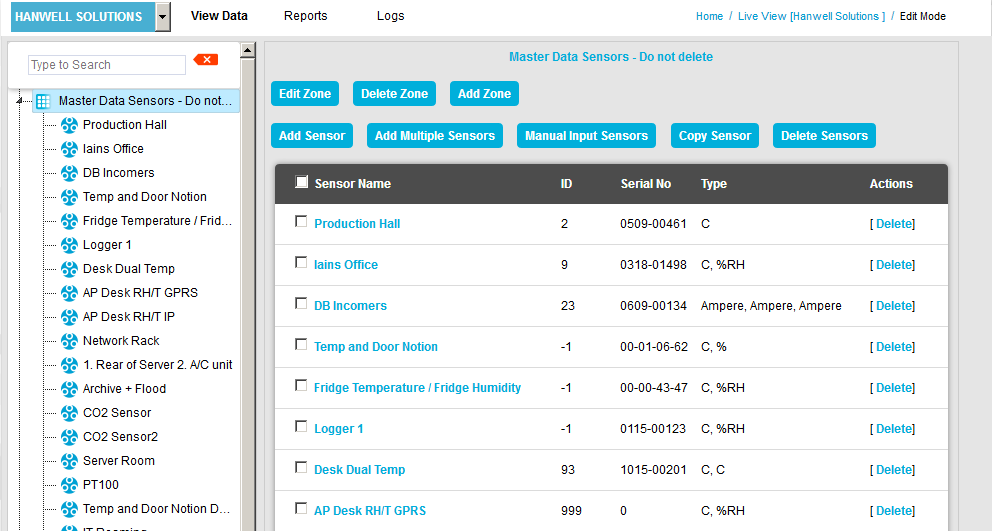
•By default, the Edit Mode window for the Zone at the top of the left-hand menu is displayed.
➢To display another Zone's Edit Mode window, click on the entry for the required Zone in the left-hand menu. For an example. See Figure 698 below:
Figure 698
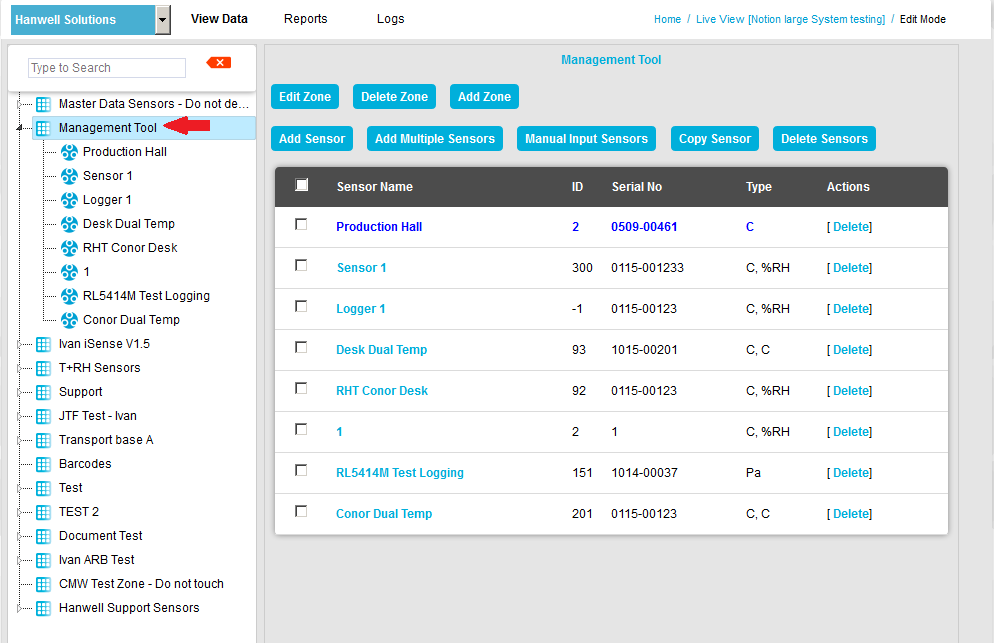
| Note: | Edit Mode is only available if you have the correct access Permissions. If you do not have the correct access Permissions, the following message window will be displayed. Figure 699 below: |
Figure 699

4.Click on the Add Sensor button (see Figure 699 above) to display the General Information pane of the Add Sensor window for the selected Zone. See Figure 700 below:
Figure 700

•You will notice, in the example above, that the Zone 'Master Data Sensors' is highlighted. This is the Zone that the new Sensor will be added to.
•Clicking in the Sensor Name field once or twice displays a list of Sensors already associated with the selected Zone, in ascending or descending alphabetical Sensor Name order.
5.Fill in the details of the Sensor to be added to the selected Zone.
•Sensor Name
Here you can type a name for the Sensor that means something in relation to either the type of measurement that the Sensor is making or the location, for example, RH/T Room 1 or Room 1.
For this example we are going to call our Sensor, 'RH/T Room 1'.
The ‘family’ for the Sensor you are adding.
Select from:
➢Hanwell Pro Radio
➢iSense
➢Hanwell IceSpy Radio
➢Manual Input
➢Hanwell Pro Logger
➢Hanwell IceSpy Legacy Scout
➢Selsium
➢ML/RL2000
Select the type of Sensor you are adding from the Sensor Type drop-down menu. See Figure 701 below:
Figure 701
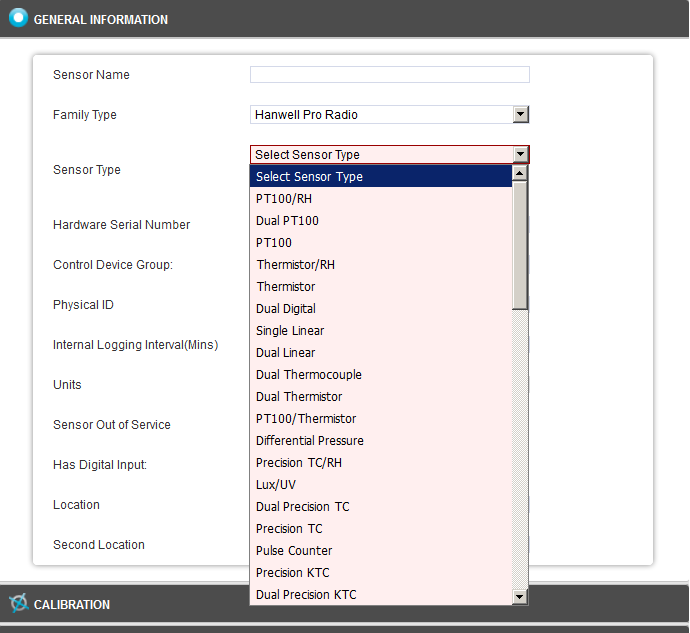
For example: Standard Temperature and Humidity Sensors can be found in the drop-down list as Thermistor/RH.
➢Descriptions of all of the available Sensor types can be found on our website.
This is the Transmitter's Serial Number and can be found on the back of the transmitter.
You can either:
Enter the Serial Number in the dialog box in the following format: 0113-00001
Or:
Enter a 0 (zero).
If a 0 (zero) is entered, the Serial Number will be filled in automatically by the EMS Management Application when the Sensor is synchronised. For details see Document: IM6000 EMS Remote Management Tool User Guide.
➢The Control Device Group is the wireless receiving device that will receive the data from the transmitters.
➢The Control Device Group is selected from the drop-down menu.
oSelect the Control Device Group which corresponds to the Site and is compatible with the wireless transmitters used at that Site.
oFor more details see the Adding Control Devices section.
oFor this example, we are going to select Hanwell.
•Physical ID
➢This is the Unique Sensor ID, it can be in the range 1 to 255.
➢For this example we are going to select Sensor 1.
➢If the Physical ID is already used by another Sensor, the System will suggest the next available ID.
•Internal Logging Interval (Mins)
➢The time, in minutes, between the Sensor's Logging/Parameter Sampling events.
•Send Interval
➢For certain Families of Sensor (for example iSense) this Value sets the interval between times when logged data is sent to the Hanwell Remote Data Service.
| CAUTION: | Changing the Send Interval and Internal Logging Interval (Mins) values in EMS (Edit Mode) for an iSense Unit will flush any unsent data from the iSense Unit’s memory. |
The Optional Details are:
•Units
This is the measurement Units for each of the channels for the Sensor/Transmitter.
➢These cannot be changed here as they are set by the Sensor/Transmitter install.
•Sensor Out of Service
This feature allows you to temporally take a Sensor out of service. This is useful if the Sensor/Transmitter is measuring something that is turned off for a period and monitoring is not required.
➢It avoids alarms being generated while the Sensor/Transmitter is not required.
➢Out of Service Sensors are displayed with blue text in the Live View.
•Has Digital Input
Checking this box registers that at least one of the Sensor's channels monitors a digital signal.
•Location
Second Location
The Location and Second Location fields allow you to put notes against the Sensor to assist with physically locating the Sensor/Transmitter within a building.
➢These are aide-mémoires only, serve no operational function within the software and are not mandatory.
•Sensor Property functionality is accessed by clicking on the relevant panes at the bottom of the Edit Mode window. See Figure 702 below (Click on the relevant image to navigate to information on the parameters for each Sensor Property):
Figure 702
6.Once you are happy with the details click on the Save button to add the Sensor to the Zone.
➢Click on the Back button to cancel adding the Sensor to the Zone.
•The new Sensor will now be displayed in the list on the left hand side of the screen along with any other Sensors associated with the Zone.
•A green dialog box is displayed confirming that the Sensor has been added to the selected Zone. See Figure 703 below:
Figure 703
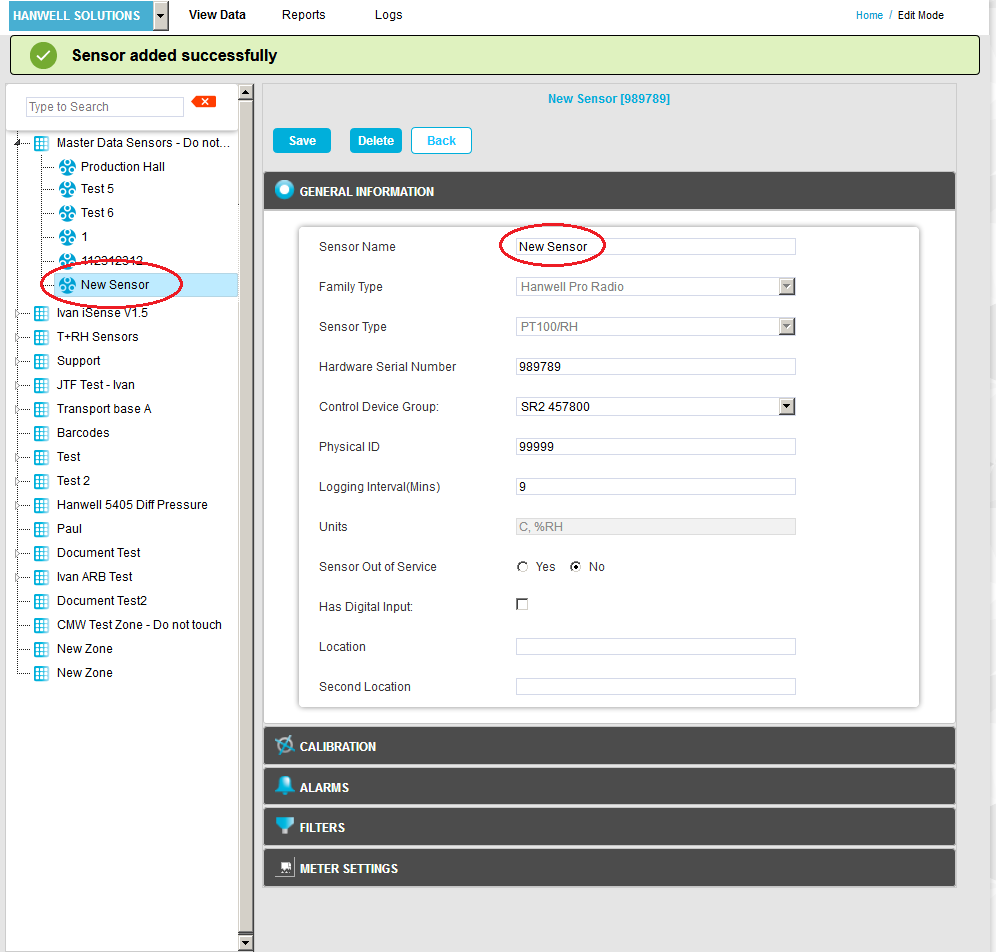
•Further Sensors can be added by repeating the steps from paragraph 2 onwards.
•When adding more Sensors, additional Zones can also be added and additional Sensors added to those Zones.
•Associating a Sensor with a CR3 GPRS Control Device.
iSense Sensors are handled as a special Sensor in EMS. •They are not part of a Control Device Group and have a special PID value of zero. •EMS collects iSense data by making an outgoing TCP/IP connection to the Hanwell Remote Data Service. ➢As this connection is made to the standard HTTP Port (8081) on the Hanwell Remote Data Service, the System operates in the vast majority of cases with no need to make Network or Firewall configuration changes. |
If a 16 Channel Digital Device/Sensor such as GutterWatch is added/assigned to a Zone it will be represented in EMS as eight Dual Channel Sensors with a 'master' Sensor defining the General Information parameters for all eight. See Figure 704 below: Figure 704
➢The seven 'non-master' Sensors will have IDs automatically assigned by EMS. |
Adding Multiple Sensors to a Zone
Multiple Sensors of the same Family Type, Sensor Type and Model and with the same Control Device can be added to a Zone as a batch.
1.Click on the Add Multiple Sensors button in the Zone's Edit Mode window. See Figure 705 below:
Figure 705
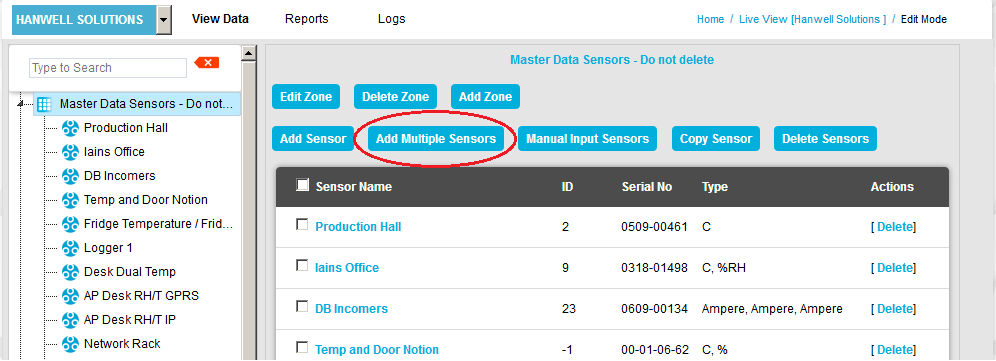
2.The Add Multiple Sensor window is displayed. See Figure 706 below:
Figure 706
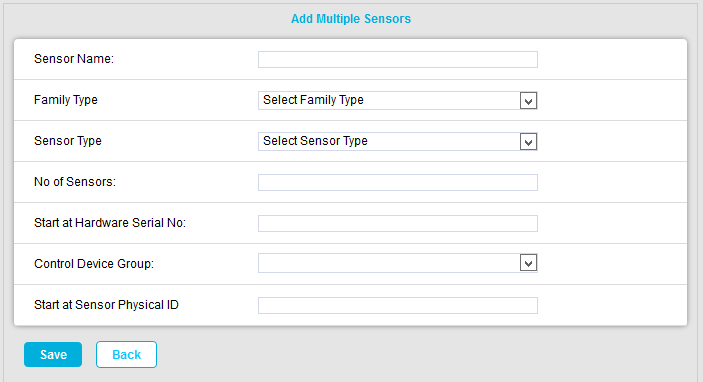
3.Fill in or select the required Sensors' details from the dialog boxes and drop-down lists in the window:
•Sensor Name:
The name to be allocated to all of the added Sensors.
•No of Sensors:
The number of Sensors you want to add in the batch.
•Start at Hardware Serial No:
The individual Sensor's Serial Numbers in the batch will be numbered sequentially from the value you enter here.
•Start at Sensor Physical ID:
The individual Sensor's Physical IDs in the batch will be numbered sequentially from the value you enter here.
4.Click on the Save button to add the batch of Sensors.
•The batch of Sensors is added and you are returned to the Zone's Edit Mode window.
•Click on the Back button to cancel adding multiple sensors.

